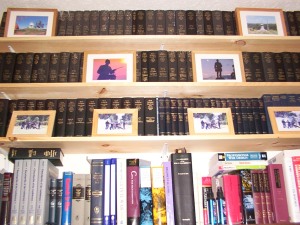
I have one shelf of books that sits right over my desk on which I put what I refer to as my “reference books.” I like to have them there because my library is in some disarray, and I want to be able to find most of these quickly. I’m going to share these with you now, for no particular reason. I’ll move left to right, and provide links to where you can find the books for purchase and/or descriptions. The ORs aren’t on this shelf, obviously, though I do keep a few volumes on the next shelf up and have the DVD in my laptop all the time (I’ve rearranged things since the above photo was taken, and almost all of my ORs are in storage now, waiting for a good home). Also further up are volumes of the Army Register and The Rebellion Record and The Union Army and The Military Historical Society of Massachusetts papers and Lincoln’s Collected Works and Lincoln Day-by-Day. But this shelf is for the most used books.
- The Confederate General (6 volumes)
- Simon & Schuster’s Encyclopedia of the Confederacy (4 volumes)
- Generals in Gray
- More Generals in Gray
- Staff Officers in Gray
- Confederate Colonels
- Lee’s Colonels (4th edition) There is a new 5th edition
- Units of the Confederate States Army
- Personnel of the Civil War (2 volumes)
- Generals in Blue
- Historical Register and Dictionary of the Army
- Colonels in Blue (3 volumes – sold separately)
- Brevet Brigadier Generals in Blue
- Who Was Who in the Civil War (Single volume edition)
- Lest We Forget
- Generals at Rest
- Final Camping Ground
- Civil War High Commands
- The Union Army (2 volumes sold separately)
- Regimental Losses in the American Civil War
- New York in the War of the Rebellion
- A Compendium of the War of the Rebellion (Single volume Morningside edition)
- Civil War Naval Chronology
- Statistical Record
- Numbers and Losses in the Civil War in America
- The Civil War Dictionary
- The Civil War Day by Day
- The Encyclopedia of Civil War Usage
- Military Bibliography of the Civil War (4 volumes sold separately)
- The Civil War in Books
- Civil War Guns
- Field Artillery Weapons of the Civil War
- Field Artillery Ordnance 1861-1865
- The Civil War Military Machine
- Arms and Equipment of the Civil War
- Battle in the Civil War
- They Fought for the Union
- Arco’s Dictionary of Military Terms (1988 edition)
I have other reference works, encyclopedias, desk references and such, but I don’t use them nearly as much as I use these.









































































Recent Comments